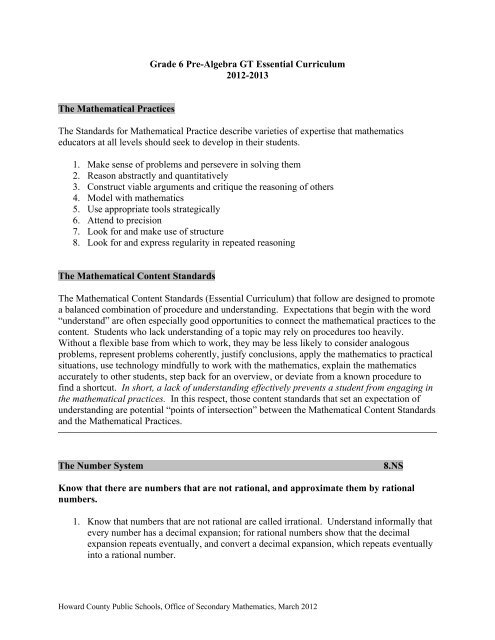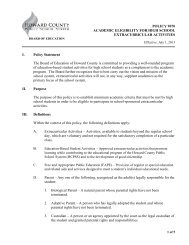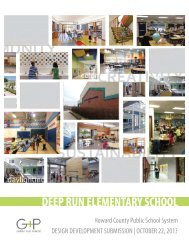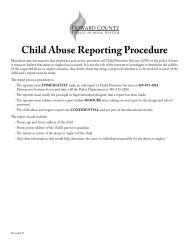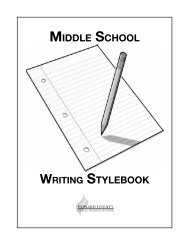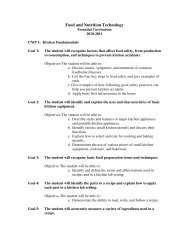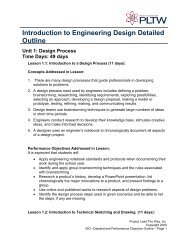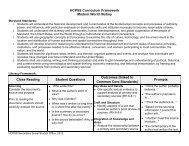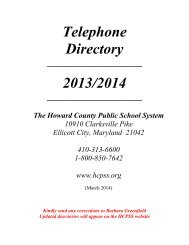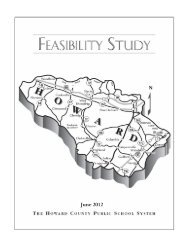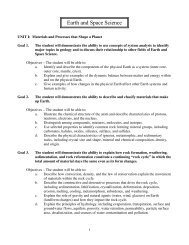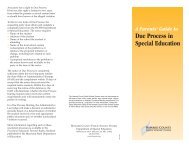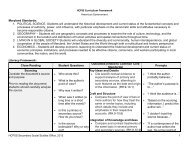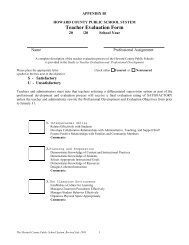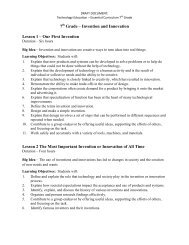Pre-Algebra GT - Howard County Public Schools
Pre-Algebra GT - Howard County Public Schools
Pre-Algebra GT - Howard County Public Schools
Create successful ePaper yourself
Turn your PDF publications into a flip-book with our unique Google optimized e-Paper software.
The Mathematical Practices<br />
Grade 6 <strong>Pre</strong>-<strong>Algebra</strong> <strong>GT</strong> Essential Curriculum<br />
2012-2013<br />
The Standards for Mathematical Practice describe varieties of expertise that mathematics<br />
educators at all levels should seek to develop in their students.<br />
1. Make sense of problems and persevere in solving them<br />
2. Reason abstractly and quantitatively<br />
3. Construct viable arguments and critique the reasoning of others<br />
4. Model with mathematics<br />
5. Use appropriate tools strategically<br />
6. Attend to precision<br />
7. Look for and make use of structure<br />
8. Look for and express regularity in repeated reasoning<br />
The Mathematical Content Standards<br />
The Mathematical Content Standards (Essential Curriculum) that follow are designed to promote<br />
a balanced combination of procedure and understanding. Expectations that begin with the word<br />
“understand” are often especially good opportunities to connect the mathematical practices to the<br />
content. Students who lack understanding of a topic may rely on procedures too heavily.<br />
Without a flexible base from which to work, they may be less likely to consider analogous<br />
problems, represent problems coherently, justify conclusions, apply the mathematics to practical<br />
situations, use technology mindfully to work with the mathematics, explain the mathematics<br />
accurately to other students, step back for an overview, or deviate from a known procedure to<br />
find a shortcut. In short, a lack of understanding effectively prevents a student from engaging in<br />
the mathematical practices. In this respect, those content standards that set an expectation of<br />
understanding are potential “points of intersection” between the Mathematical Content Standards<br />
and the Mathematical Practices.<br />
The Number System 8.NS<br />
Know that there are numbers that are not rational, and approximate them by rational<br />
numbers.<br />
1. Know that numbers that are not rational are called irrational. Understand informally that<br />
every number has a decimal expansion; for rational numbers show that the decimal<br />
expansion repeats eventually, and convert a decimal expansion, which repeats eventually<br />
into a rational number.<br />
<strong>Howard</strong> <strong>County</strong> <strong>Public</strong> <strong>Schools</strong>, Office of Secondary Mathematics, March 2012
2. Use rational approximations of irrational numbers to compare the size of irrational<br />
numbers, locate them approximately on a number line diagram, and estimate the value of<br />
expressions (e.g., π 2 ). For example, by truncating the decimal expansion of 2 , show<br />
that 2 is between 1 and 2, then between 1.4 and1.5, and explain how to continue on to<br />
get better approximations.<br />
Notes:<br />
• Students will need to review operations with integers (<strong>Pre</strong>-<strong>Algebra</strong> Unit 1: Goal 2,<br />
Objective 1: The student will be able to add, subtract, multiply and divide integers)<br />
• Students may also need review of dividing fractions. Check student understanding<br />
and review as needed (<strong>Pre</strong>-<strong>Algebra</strong> Unit 8: Standard 6, Goal 1, Objective 1: The<br />
student will be able to add, subtract, multiply and divide fractions).<br />
Expressions and Equations 8.EE<br />
Note: Students may need to review simplifying expressions.<br />
Work with radicals and integer exponents.<br />
1. Know and apply the properties of integer exponents to generate equivalent numerical<br />
expressions. For example, 3 2 × 3 −5 = 3 −3 = 1 / 3 3 = 1 / 27 .<br />
2. Use square root and cube root symbols to represent solutions to equations of the form<br />
x 2 = p and x 3 = p , where p is a positive rational number. Evaluate square roots of small<br />
perfect squares and cube roots of small perfect cubes. Know that 2 is irrational.<br />
3. Use numbers expressed in the form of a single digit times an integer power of 10 to<br />
estimate very large or very small quantities, and to express how many times as much one<br />
is than the other. For example, estimate the population of the United States as 3 × 10 8<br />
and the population of the world as 7 × 10 9 , and determine the world population is more<br />
than 20 times larger.<br />
4. Perform operations with numbers expressed in scientific notation, including problems<br />
where both decimal and scientific notation are used. Use scientific notation and choose<br />
units of appropriate size for measurements of very large or very small quantities (e.g., use<br />
millimeters per year for seafloor spreading). Interpret scientific notation that has been<br />
generated by technology.<br />
Understand the connections between proportional relationships, lines, and linear<br />
equations.<br />
5. Graph proportional relationships, interpreting the unit rate as the slope of the graph.<br />
Compare two different proportional relationships represented in different ways. For<br />
example, compare a distance-time graph to a distance-time equation to determine which<br />
<strong>Howard</strong> <strong>County</strong> <strong>Public</strong> <strong>Schools</strong>, Office of Secondary Mathematics, March 2012
of two moving objects has greater speed.<br />
6. Use similar triangles to explain why the slope m is the same between any two distinct<br />
points on a non-vertical line in the coordinate plane; derive the equation y = mx for a<br />
line through the origin and the equation y = mx + b for a line intercepting the vertical<br />
axis at b.<br />
Analyze and solve linear equations and pairs of simultaneous linear equations.<br />
7. Solve linear equations in one variable.<br />
a. Give examples of linear equations in one variable with one solution, infinitely<br />
many solutions, or no solutions. Show which of these possibilities is the case by<br />
successively transforming the given equation into simpler forms, until an<br />
equivalent equation of the form x = a, a = a, or a = b results (where a and b are<br />
different numbers).<br />
b. Solve linear equations with rational number coefficients, including equations<br />
whose solutions require expanding expressions using the distributive property and<br />
collecting like terms.<br />
8. Analyze and solve pairs of simultaneous linear equations.<br />
a. Understand that solutions to a system of two linear equations in two variables<br />
correspond to points of intersection of their graphs, because points of intersection<br />
satisfy both equations simultaneously.<br />
b. Solve systems of two linear equations in two variables algebraically, and estimate<br />
solutions by graphing the equations. Solve simple cases by inspection. For<br />
example, 3x + 2y = 5 and 3x + 2y = 6 have no solutions because 3x + 2y<br />
cannot simultaneously be 5 and 6.<br />
c. Solve real-world and mathematical problems leading to two linear equations in<br />
two variables. For example, given coordinates for two pairs of points, determine<br />
whether the line through the first pair of points intersects the line through the<br />
second pair.<br />
Functions 8.F<br />
Note: Since this is the first exposure to multiple representations of functions, students may<br />
need additional support.<br />
Define, evaluate, and compare functions.<br />
1. Understand that a function is a rule that assigns to each input exactly one output. The<br />
graph of a function is the set of ordered pairs consisting of an input and the corresponding<br />
output.<br />
<strong>Howard</strong> <strong>County</strong> <strong>Public</strong> <strong>Schools</strong>, Office of Secondary Mathematics, March 2012
2. Compare properties of two functions each represented in a different way (algebraically,<br />
graphically, numerically in tables, or by verbal descriptions). For example, given a<br />
linear function represented by a table of values and a linear function represented by an<br />
algebraic expression, determine which function has the greater rate of change.<br />
3. Interpret the equation y = mx + b as defining a linear function, whose graph is a straight<br />
line; give examples of functions that are not linear. For example, the function A = s 2<br />
giving the area of a square as a function of its side length is not linear because its graph<br />
contains points (1, 1), (2, 4), and (3, 9), which are not on a straight line.<br />
Use functions to model relationships between quantities.<br />
4. Construct a function to model a linear relationship between two quantities. Determine<br />
the rate of change and initial value of the function from a description of a relationship or<br />
from two (x, y) values, including reading these from a table or from a graph. Interpret the<br />
rate of change and initial value of a linear function in terms of the situation it models, and<br />
in terms of its graph or a table of values.<br />
5. Describe qualitatively the functional relationship between two quantities by analyzing a<br />
graph (e.g., where the function is increasing or decreasing, linear or nonlinear). Sketch a<br />
graph that exhibits the qualitative features of a function that has been described verbally.<br />
Geometry 8.G<br />
Note: There needs to be an emphasis on using appropriate mathematical vocabulary.<br />
Students will need to begin to develop arguments and justifications.<br />
Understand congruence and similarity using physical models, transparencies, or geometry<br />
software.<br />
1. Verify experimentally the properties of rotations, reflections, and translations:<br />
a. Lines are taken to lines, and line segments to line segments of the same length.<br />
b. Angles are taken to angles of the same measure.<br />
c. Parallel lines are taken to parallel lines.<br />
2. Understand that a two-dimensional figure is congruent to another if the second can be<br />
obtained from the first by a sequence of rotations, reflections, and translations; given two<br />
congruent figures, describe a sequence that exhibits the congruence between them.<br />
3. Describe the effect of dilations, translations, rotations, and reflections on twodimensional<br />
figures using coordinates.<br />
4. Understand that a two-dimensional figure is similar to another if the second can be<br />
obtained from the first by a sequence of rotations, reflections, translations, and dilations;<br />
<strong>Howard</strong> <strong>County</strong> <strong>Public</strong> <strong>Schools</strong>, Office of Secondary Mathematics, March 2012
given two similar two-dimensional figures, describe a sequence that exhibits the<br />
similarity between them.<br />
5. Use informal arguments to establish facts about the angle sum and exterior angle of<br />
triangles, about the angles created when parallel lines are cut by a transversal, and the<br />
angle-angle criterion for similarity of triangles. For example, arrange three copies of the<br />
same triangle so that the sum of the three angles appears to form a line, and give an<br />
argument in terms of transversals why this is so.<br />
Understand and apply the Pythagorean Theorem.<br />
6. Explain a proof of the Pythagorean Theorem and its converse.<br />
7. Apply the Pythagorean Theorem to determine unknown side lengths in right triangles in<br />
real-world and mathematical problems in two and three dimensions.<br />
8. Apply the Pythagorean Theorem to find the distance between two points in a coordinate<br />
system.<br />
Note: Teachers also need to introduce concept of midpoint in this unit of study.<br />
Solve real-world and mathematical problems involving volume of cylinders, cones, and<br />
spheres.<br />
9. Know the formulas for the volumes of cones, cylinders, and spheres and use them to<br />
solve real-world and mathematical problems.<br />
Statistics and Probability 8.SP<br />
Investigate patterns of association in bivariate data.<br />
1. Construct and interpret scatter plots for bivariate measurement data to investigate patterns<br />
of association between two quantities. Describe patterns such as clustering, outliers,<br />
positive or negative association, linear association, and nonlinear association.<br />
2. Know that straight lines are widely used to model relationships between two quantitative<br />
variables. For scatter plots that suggest a linear association, informally fit a straight line,<br />
and informally assess the model fit by judging the closeness of the data points to the line.<br />
3. Use the equation of a linear model to solve problems in the context of bivariate<br />
measurement data, interpreting the slope and intercept. For example, in a linear model<br />
for a biology experiment, interpret a slope of 1.5 cm/hr as meaning that an additional<br />
hour of sunlight each day is associated with an additional 1.5 cm in mature plant height.<br />
<strong>Howard</strong> <strong>County</strong> <strong>Public</strong> <strong>Schools</strong>, Office of Secondary Mathematics, March 2012
4. Understand that patterns of association can also be seen in bivariate categorical data by<br />
displaying frequencies and relative frequencies in a two-way table. Construct and<br />
interpret a two-way table summarizing data on two categorical variables collected from<br />
the same subjects. Use relative frequencies calculated for rows or columns to describe<br />
possible association between two variables. For example, collect data from students in<br />
your class on whether or not they have a curfew on school nights and whether or not they<br />
have assigned chores at home. Is there evidence that those who have a curfew also tend<br />
to have chores?<br />
<strong>Howard</strong> <strong>County</strong> <strong>Public</strong> <strong>Schools</strong>, Office of Secondary Mathematics, March 2012


